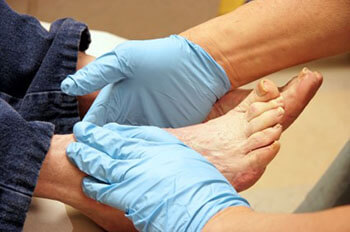
Unfortunately, foot problems are often a common result of having diabetes. As time goes by, it’s likely that diabetes can cause nerve damage, also known as diabetic neuropathy. This can lead to tingling or a painful sensation, and it may also cause you to lose feeling in your feet. The loss of feeling in your feet can become incredibly dangerous, especially if you can longer sense a blister or cut on your foot; this can lead to sores or infections.
There are many ways to maintain healthy foot care when dealing with diabetes. Most importantly, you want to ensure that you’re managing your blood glucose levels, otherwise known as your blood sugar. You also want to ensure that you’re checking your feet daily. As mentioned before, it’s important to recognize if your feet have cuts, sores, blisters, plantar warts, ingrown toenails, or other troubling foot conditions to stay ahead of the issue and prevent yourself from further harm. Along with foot checks, you should also wash and dry your feet daily using lukewarm water. It may also be useful in certain cases to moisturize your feet a few times a week, especially if you’re prone to dryness. Please be advised, however, to avoid moisturizing between the toes as they will not dry properly. Another rule you may want to follow is to ensure you’re cutting your toenails straight across. You should also refrain from digging into the sides of the toes; this will help prevent the development of an ingrown toenail. If you do happen to develop a corn or callus, never treat them yourself; seek the help of a professional. It may also be beneficial to look into socks made specifically for those with diabetes to help provide yourself with extra cushion. You may also want to refrain from walking barefoot, as well as avoid smoking, as it restricts the blood flow to your feet.
In certain serious cases, you may notice a cut, blister, or bruise is not healing after a few days. If this occurs, it’s important to seek the help of a professional. Other warning signs include redness, swelling, a callus with dried blood inside of it, or an infection that causes discoloration of the foot and an odor.
If you’d like more information on how to maintain healthy feet while living with diabetes, seek the assistance of a podiatrist who can provide you with the tips needed for healthy foot care.
Diabetes and Your Feet
In the intricate tapestry of managing diabetes, caring for your feet is a crucial aspect that demands attention. This article navigates the essential diabetic foot care guidelines, offering a comprehensive understanding of preventive measures, symptoms to watch for, and proactive strategies to maintain optimal foot health.
The Importance of Diabetic Foot Care
Grasping the Significance
Understanding why diabetic foot care is paramount and how diabetes can impact the health of your feet, potentially leading to severe complications.
Prevalence of Diabetic Foot Complications
Highlighting the prevalence of foot-related issues in individuals with diabetes and the need for proactive care to prevent complications.
Preventive Measures
Daily Foot Inspections
Guidelines on incorporating daily foot inspections into your routine, empowering individuals to identify potential issues early.
Choosing Appropriate Footwear
Educating readers on the importance of selecting comfortable, well-fitting shoes to minimize the risk of friction and pressure points.
Proper Nail Care
Offering insights into the significance of proper nail care, emphasizing the avoidance of ingrown toenails and the importance of regular trimming.
Managing Moisture and Hydration
Dry Skin Prevention
Exploring the role of moisturization in preventing dry skin, cracking, and fissures that can lead to infections.
Importance of Hydration
Stressing the correlation between adequate hydration and skin health, with practical tips on maintaining proper moisture levels.
Recognizing Warning Signs
Neuropathy Awareness
Educating readers about diabetic neuropathy, its impact on foot sensation, and the importance of regular neuropathy assessments.
Identifying Changes in Skin Color and Temperature
Guidelines on recognizing changes in skin color and temperature as potential indicators of circulation issues.
Addressing Swelling and Inflammation
Insights into the causes of swelling and inflammation in the feet and proactive measures to address these symptoms.
Strategies for Wound Prevention
Cuts and Abrasions
Highlighting the increased risk of cuts and abrasions in individuals with diabetes and providing strategies for prevention.
Callus Management
Guidelines on the safe management of calluses, emphasize the importance of professional intervention for removal.
Seeking Professional Care
Regular Podiatric Check-ups
Stressing the importance of regular podiatric check-ups for individuals with diabetes to detect and address potential issues early.
Timely Intervention
Encouraging prompt professional intervention in case of any foot issues, emphasizing the principle of "better safe than sorry."
Lifestyle Modifications
Maintaining a Healthy Lifestyle
Exploring the broader impact of overall health on diabetic foot care, including the role of diet, exercise, and blood sugar management.
Smoking Cessation
Highlighting the adverse effects of smoking on foot health and encouraging individuals with diabetes to quit smoking.
Conclusion
In conclusion, diabetic foot care is a multifaceted aspect of diabetes management that demands attention and diligence. By adhering to the outlined guidelines, individuals can empower themselves to proactively care for their feet, minimizing the risk of complications and ensuring a foundation of robust foot health. Incorporating these practices into daily life not only enhances overall well-being but also contributes to a proactive and informed approach to diabetes management. Remember, the journey towards healthy feet begins with a single step – a step towards comprehensive diabetic foot care.
